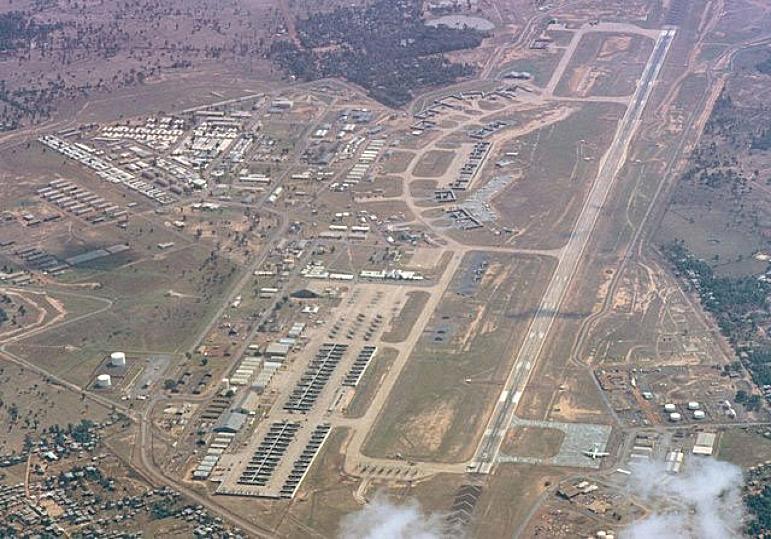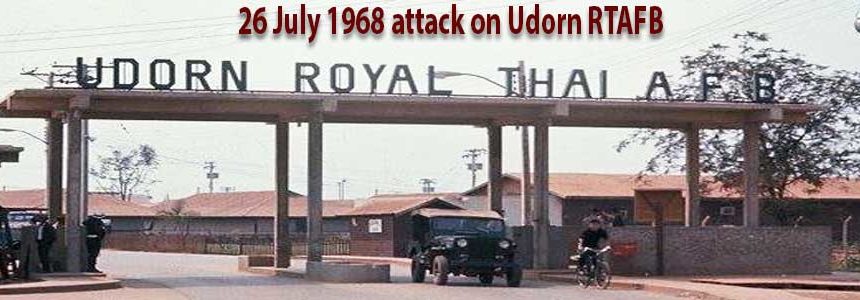The 26 July 1968 attack on Udorn RTAFB was the first overt, hostile action by either communist-inspired insurgent forces or military units of North Vietnam against United States Air Force personnel and resources located in the Kingdom of Thailand. A hostile force of unknown size attacked Udorn RTAFB at 2225 hours the night of 26 July 1968. The size of the force, which opened its attack with automatic weapons fire on the northwest end of the base, was estimated at eight to ten persons by Intelligence officers, The security police and the local Thai police, however, estimated there were up to 25 of the attackers.

The initial fire came from just outside the base perimeter at a point parallel to Runway 12 and perpendicular to Taxiway 4. The initial fire was joined by hostile fire coming from two or more positions parallel to the taxi- way and perpendicular to the runway, as well as from a point almost exactly opposite the position of the initial fire. As part of the attacking force continued to fire from these positions, other members moved toward the special air evac Sentinel Echo.
Eyewitnesses have accounted for three intruders within grenade-throwing distance of the C-141, while other evidence indicates at least three others penetrated to within 30 yards of the aircraft. The enemy reached the immediate vicinity of the C-141 and an F-4D aircraft some 50 yards away on a trim pad. They were in the area for approximately 20 minutes before being driven back by mobile USAF/Thai Security Force Quick Reaction and Security Alert Teams.

According to eyewitness reports, one intruder penetrated to the parked aircraft. He was shot and killed just under the tail of the C-141 by the close-in USAF Security Guard. Another raider got to the same general area, only about 20 yards closer to the runway. He, too, was killed by the USAF guard. A third man entered from across the runway, went toward the C-141, approached two vehicles parked just off the left wing tip, sprayed the area with AK-47 automatic fire, and ran into the grass off the taxiway to the front of the aircraft. He returned to the taxiway, going to the right side of the Starlifter, and there he lobbed an explosive charge under the aircraft fuel pouring from the damaged number two engine on the C-141. He then ran the length of the taxiway, toward the trim pad where two F-4 aircraft were parked. On the way there, he detoured slightly to a mobile security force truck. He evidently had seen USAF personnel using the truck for cover. He threw an explosive charge into the back of the truck and then continued on to the closest of the two F-4 aircraft. On the trim pad, the third hostile was seen to circle a “D” model aircraft, throw something into the tail pipe, and run off into the grass. No explosion was seen or heard. The man returned to the F-4D, again throwing something into the tail pipe. After this second attempt, a muffled explosion was heard and flames shot from the exhaust of the Phantom II. Then the intruder ran back into the grass on the east of the taxiway, and reaching a point about halfway between the trim pad and the C-141, hurried toward the base perimeter, and disappeared.

Evidence found the following morning by investigating officers indicated at least three more enemy had been in the immediate vicinity of the C-141. Blood stains, ammunition clips, and drag marks further indicated that at least one of the three had been either killed or seriously wounded during the exchange of gunfire. As the hostile group was pushed back toward the base perimeter, some of the attackers made one last concentrated effort, and unleashed a volley of automatic fire that pinned down a pursuing security alert team. A QRT arrived in the area, however, just northeast of Taxiway 4, and the hostile force continued to withdraw. The SAT, which had been pinned down, pursued the group toward the perimeter, but no further contact was made. At 0205 and 0230 hours, small arms fire was reported in the area of the road leading to the Napalm and Munitions Storage site. (Fig. 3.) An investigation of the area by a QRT disclosed no further evidence that anyone had actually been firing from or into the area.

Base Security Reaction At the time of the attack on Udorn, the close-in security guard, three maintenance men, and an aeromedical evacuation crew member were standing by a maintenance truck parked off the left wing of the C-141. They realized they were under attack when tracer bullets began passing overhead from a position across the runway. Before they could react, tracers were flying through air from several directions.
According to one maintenance man, they were under fire from every direction except down the runway and the parallel taxiway inside the base. An attempt was made to radio word of the attack to the maintenance shop, but no one answered the call. After turning off the headlights on the maintenance vehicle, an attempt was made to turn the lighting unit shining on an aircraft, toward the hostile positions in an effort to light up potential targets. While trying to turn the unit around, the bulbs were shot out. At that point, the medic made his way to the C-141 and called for the other medical and flight crew personnel aboard to get out. The medical and flight crew members evacuated the aircraft and headed for cover in the grass. En route, one crew chief received abdominal wounds, which resulted in his death several days later, and the C-141 pilot was severely wounded in both hands.
While the evacuation was being accomplished, the number two engine of the C-141 caught fire. Immediately, an HH-43 “Pedro” helicopter with a fire suppression kit flew to the scene; its crew fought the fire. The chopper and fire hose took hits, but the Pedro crew remained in the area, using rotor blast and a trickle of foam to contain the fire until several fire trucks arrived to extinguish the fire. In the meantime, the security guard was spraying first one area and then the other with M-16 automatic weapon fire. He observed three enemy approaching the aircraft, two of whom he is credited with killing.

Those killed carried AK-47 assault rifles, several extra clips of ammo, grenades and plastic type explosive charges. One of the killed did not die outright, but bled to death after being downed near the taxiway, because it was realized that he had satchel charges rigged on his body. He was kept under surveillance awaiting the arrival of EOD personnel. This individual was shot during the first few minutes of the attack, but he was not discovered until some six hours later during a sweep of the infiltrated area.
Within two minutes of the initial shots a joint USAF/TSG SAT, on standby for Sentinel Echo security, deployed from the taxiway and returned fire on the hostile positions. Within ten minutes of the first fire, the security leader, a six-man QRT, and another three-man SAT from CSC had blocked off the north/ northwest end of the base. The CSC had meanwhile effected a base recall of all off-duty security police personnel and augmentee forceSo Several additional QRTs and SATs were quickly formed and some were dispatched to strategic areas for defense of the base. Other teams were kept in reserve at CSC.
Throughout the night a C-130, called in from Korat RTAFB, and an HH-43 continued to circle over the base; their crews dropped flares and served as reconnaissance spotters. The security forces, including USAF, RTG, and American augmentees , remained on alert. Several times during the hours of darkness a QRT or SAT responded and investigated reports of sniper fire and possible infiltration attempts. Flare drops were directed over the munitions storage area in the early morning hours as the SATs searched the area, but the enemy was not discovered again. The expanded security operation was terminated at 0700 hours on 27 July after the USAF, RTAF Base Commander, and security leader determined the base was clear, and that there would be no further contact with hostile forces.
When security forces reached the northernmost corner of the base, during a more extensive sweep and security operation, which began at daybreak, they found one of the Thai Security Guards had been killed by hostile AK-47 gunfire at the time of the initial outbreak. It was believed this TSG had attempted to sound the alarm when he was shot, thereby prematurely triggering the attack. His radio had been turned on and was in the transmit position; his carbine had been loaded and cocked.
A report was prepared by the 7/13AF AD Hoc Committee in September 1968, summarized: The attack was a small unit raid which seemingly had relatively limited objectives. No mass attack was carried out and the few aircraft which were damaged were repaired and operational a few days later. While two were killed on the friendly side (one Thai Guard and a C-141 crew chief), the enemy probably suffered heavier casualties.
More significant, however, was that long standing weaknesses in base defense posture were clearly pointed out and through greater emphasis and concentration on outstanding problems, it seemed obvious that the enemy would not again find Thai base defenses in similar conditions. The attack, whether or not the enemy accomplished his objectives, helped improve base defense plans, operations, and coordination.



